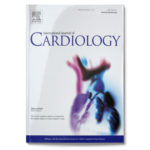Ретроспективный анализ медицинских карт 49 292 японских пациентов показал, что у практически здоровых людей гиперурикемия является независимым фактором риска развития фибрилляции предсердий.
ПРЕДПОСЫЛКИ:
Взаимосвязь между уровнем мочевой кислоты в сыворотке (МКС) и фибрилляцией предсердий (ФП) остается до конца неясной, поскольку на развитие ФП влияет множество факторов и заболеваний. Данное исследование проведено с целью прояснить роль гиперурикемии как независимого конкурирующего фактор риска развития ФП в общей популяции практически здоровых людей.
МЕТОДЫ:
Мы провели ретроспективный анализ 90 143 медицинских карт японцев, которые проходили ежегодную диспансеризацию в Международной клинике Св. Луки в г. Токио с января 2004 г. по июнь 2010 г. У 291 (0,32%) этих пациентов ЭКГ в 12 отведениях показала наличие ФП. Сначала мы проанализировали данные 90 117 пациентов, чтобы установить независимые конкурирующие факторы риска ФП, и получили отношения шансов (ОШ) для анализа по методу логистической регрессии. Затем мы исключили 40 825 пациентов с гипертензией, сахарным диабетом, дислипидемией, хронической болезнью почек и пациентов, принимавших на момент обследования препараты для лечения гиперурикемии и (или) подагры, и проанализировали данные 49 292 пациентов.
РЕЗУЛЬТАТЫ:
При первичном анализе в группах с ФП уровень МКС был значимо выше (ОШ: 1,35; 95% доверительный интервал (ДИ): 1,22–1,50), чем в группе без ФП. ОШ гиперурикемии (МКС > 7,0 мг/дл) для ФП составило 2,75 (95% ДИ: 2,10–3,60). Затем после внесения корректировок было показано, что повышенный уровень МКС (ОШ: 1,53; 95% ДИ: 1,21–1,92) — значимый независимый конкурирующий фактор риска ФП, наравне с пожилым возрастом, мужским полом, высоким индексом массы тела, низкими ОФВ1/ФЖЭЛ и высоким гемоглобином. ОШ гиперурикемии для ФП составило 3,19 (95% ДИ: 1,18–5,62).
ВЫВОДЫ:
Гиперурикемия — независимый конкурирующий фактор риска ФП. Требуются дальнейшие проспективные интервенционные исследования важности снижения уровня МКС для профилактики ФП.

Int J Cardiol. 2016 Nov 15.
PMID: 27871785 DOI: 10.1016/j.ijcard.2016.11.268
Kuwabara M1, Niwa K2, Nishihara S2, Nishi Y2, Takahashi O3, Kario K4, Yamamoto K5, Yamashita T6, Hisatome I7.
1 Department of Cardiology, St. Luke’s International Hospital, Tokyo, Japan; Division of Regenerative Medicine and Therapeutics, Institute of Regenerative Medicine and Biofunction, Tottori University Graduate School of Medical Sciences, Yonago, Japan; Department of Cardiology, Toranomon Hospital, Tokyo, Japan. Electronic address: kuwamasa728@gmail.com. 2 Department of Cardiology, St. Luke’s International Hospital, Tokyo, Japan. 3 Center for Clinical Epidemiology, St. Luke’s International University, Tokyo, Japan. 4 Division of Cardiovascular Medicine, Department of Medicine, Jichi Medical University School of Medicine, Shimotsuke, Japan. 5 Division of Cardiovascular Medicine, Endocrinology and Metabolism, Department of Molecular Medicine and Therapeutics, Faculty of Medicine, Tottori University, Yonago, Japan. 6 The Cardiovascular Institute, Tokyo, Japan. 7 Division of Regenerative Medicine and Therapeutics, Institute of Regenerative Medicine and Biofunction, Tottori University Graduate School of Medical Sciences, Yonago, Japan.
![]()
Hyperuricemia is an independent competing risk factor for atrial fibrillation
BACKGROUNDS:
The relationship between serum uric acid (SUA) and atrial fibrillation (AF) remains unclear because many parameters and diseases influence AF. This study was conducted to clarify the role of hyperuricemia as an independent competing risk factor for AF in an apparently healthy general population.
METHODS:
We retrospectively analyzed the medical records of 90,143 Japanese subjects who underwent annual regular health check-up in St. Luke’s International Hospital, Tokyo, between January 2004 and June 2010. Of those subjects, 291 (0.32%) were identified as having AF by 12 leads electrocardiography. First, we analyzed 90,117 subjects to clarify the independent competing risk factors for AF and obtained odds ratios (ORs) by logistic regression analysis. Second, we excluded 40,825 subjects with hypertension, diabetes mellitus, dyslipidemia, chronic kidney disease, and current medication for hyperuricemia and/or gout, and we analyzed 49,292 subjects.
RESULTS:
First, AF groups were significantly higher SUA level (OR: 1.35; 95% confidence interval (CI), 1.22-1.50) than non-AF group. OR of hyperuricemia (>7.0mg/dL of SUA) for AF was 2.75 (95% CI, 2.10-3.60). Second, after multiple adjustments, higher SUA level (OR: 1.53; 95% CI, 1.21-1.92) was a significantly independent competing risk factor for AF, as well as older age, male sex, higher body mass index, lower FEV1/FVC, and higher hemoglobin. OR of hyperuricemia for AF was 3.19 (95% CI, 1.81-5.62).
CONCLUSIONS:
Hyperuricemia is an independent competing risk factor for AF. Further prospective intervention studies are needed to prove whether lowering SUA level might be important for preventing AF or not.
Copyright © 2016 Elsevier Ireland Ltd. All rights reserved.
